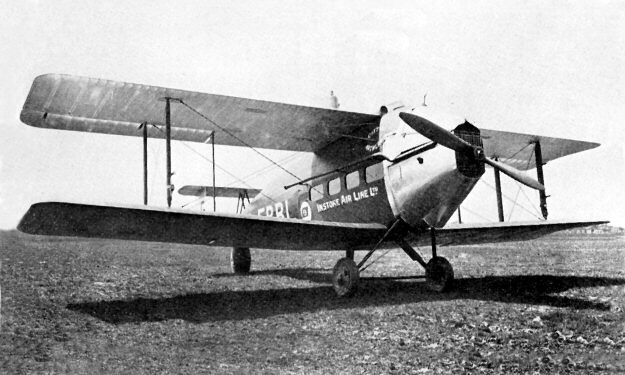
ASN Wikibase Occurrence # 233089
This information is added by users of ASN. Neither ASN nor the Flight Safety Foundation are responsible for the completeness or correctness of this information.
If you feel this information is incomplete or incorrect, you can submit corrected information.
| Date: | Friday 23 June 1922 |
| Time: | afternoon |
| Type: | Vickers Type 61 Vulcan |
| Owner/operator: | Instone Air Lines |
| Registration: | G-EBBL |
| MSN: | 61/1 |
| Fatalities: | Fatalities: 0 / Occupants: 1 |
| Aircraft damage: | Substantial |
| Location: | near Tonbridge, Kent, England -
 United Kingdom United Kingdom
|
| Phase: | En route |
| Nature: | Passenger - Scheduled |
| Departure airport: | Brussels, Belgium |
| Croydon Airport, Surrey (EGCR) | |
| Confidence Rating: |
Vickers Type 61 Vulcan G-EBBL first registered (C of R 797) to Instone Air Lines Ltd on 24 February 1922. C/no. given as "Vulcan No.1"
Vickers Vulcan G-EBBL, owned by Instone Air Line and flown by a Mr. R.E. Keys, came to grief near Tonbridge on the afternoon of 23rd June 1922. Almost brand-spanking new, G-EBBL had first flown on 7th May of that year and had been put into commission on the Channel Service on 1st June. The pilot had first flown the Vulcan on the day before the accident, making a trial 15 minute flight before flying to Brussels with goods and one passenger. The return flight the following day caused him problems..
G-EBBL left Brussels with both petrol tanks full, and throughout the journey the 360 h.p. Rolls Royce Eagle VIII engine was kept throttled back to cruising speed (1780-1800 rpm). During the flight the fuel gauges appeared to function normally, although the starboard indicator dropped more rapidly than the port one and the pilot closed the starboard cock for about 20 minutes to equalise the petrol in the tanks. When at 2000 feet over Tonbridge the engine failed completely - the pilot noted that the port fuel guage was about 4" above the 'empty' mark and the starboard one 3". Selecting a handy field for a landing, Keys approached from the west and passed over the boundary only a few feet above bordering hedges but flying almost directly downwind. G-EBBL didn't lose flying speed until it was nearly across the field, consequently running into the trees on the far side. The Vulcan tipped over onto its nose at an angle of 45 degrees, the pilot escaping unscathed. The fuselage and engine were practically undamaged, as were the fuel tanks, the main damage being the badly crushed wings.
Inspection showed that both fuel tanks were empty, despite the gauges reading 2.5" above 'empty'. The engine was running on an abnormally rich mixture, with not one of the four carburettor variable jets being adjusted in accordance with the maker's recommendations. The accident was blamed on faulty gauges, a small leak from a connection on one of those gauges, and an error of judgement on the part of the pilot when making the landing. He was also punished for flying in contravention of the Air Navigation Regulations, not being licensed to fly the Vulcan for hire or reward.
In 1923 the British Government "suggested" that all the smaller carriers should merge, and form a national airline, to be named Imperial Airways, Instone was one of the airlines absorbed by that carrier, which flew its first services on 1 April 1924. G-EBBL did fly for a short while with Imperial, but was withdrawn from service in May, 1924. G-EBBL was cancelled as "lapsed" with no date recorded on the aircraft's record card. As far as is known G-EBBL was scrapped at Croydon Airport, probably before the end of 1924.
While the Vickers Type 61 Vulcan was not a success - only eight were built, and, due to its bulbous shape, it acquired the sobriquet of 'the Flying Pig'! - it is worth noting that it could fly from London (Croydon) to Paris (Le Bourget) in 1922 in a time that was only 15 minutes longer than British Airways takes to fly from London to Paris 100 years later...
Sources:
1. https://en.wikipedia.org/wiki/Vickers_Vulcan#Individual_aircraft
2. https://cwsprduksumbraco.blob.core.windows.net/g-info/HistoricalLedger/G-EBBL.pdf
3. National Archives (PRO Kew) File AVIA 5/4/C56: https://discovery.nationalarchives.gov.uk/details/r/C6576524
4. https://www.flickr.com/photos/27862259@N02/6442784615
5. http://sussexhistoryforum.co.uk/index.php?topic=2622.0
Media:


Revision history:
| Date/time | Contributor | Updates |
|---|---|---|
| 19-Feb-2020 18:53 | Dr. John Smith | Added |
| 28-Jun-2022 15:08 | Dr. John Smith | Updated [Embed code, Narrative, Category] |
| 13-Jun-2023 20:50 | Nepa | Updated [[Embed code, Narrative, Category]] |
Corrections or additions? ... Edit this accident description
The Aviation Safety Network is an exclusive service provided by:


 ©2024 Flight Safety Foundation
©2024 Flight Safety Foundation